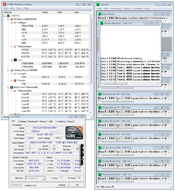A manual overclock - Core i7 980X
A manual overclock - Core i7 980X
With the Front Side Bus officially annihilated, things tend to change a little in the overclocking department. Only a little though. It's a little weird but the concept remains the same. After enabling manual overclocking in the BIOS you'll find a 133 MHz register called the Base clock; look at that as your 'FSB' to play around with. Of course, if you have an Extreme Edition processor, things are much easier. Just play around with CPU voltages and the multiplier and even on the stock air cooler you can achieve some pretty snazzy results.
First up, check what your current values are. The X58 mainboard applies a dynamic multiplier. A baseclock of 133 MHz times a multiplier of 25 is 3.33 GHz. That is your base clock frequency. In the default configuration it can also apply a multiplier of 26 with Turbo mode enabled. So your Core i7 processor will go beyond spec at default already.
If you want to overclock extensively by hand, first off in the BIOS please disable Speedstep, C1E and TM functions preventing the processor from clocking down or up dynamically based on diverse variables including heat and CPU load. We now simply increase the multiplier until the system crashes, then increase voltages and start over again. Inevitably we'll find our maximum frequency or temperatures simply get out of hand.
For our overclock we increased the voltage on the processor and used a Noctua NH D14 heatpipe cooler on it. Typically we end up at 4.1 ~4.2 GHz with the Core i7 980X processor.
Keep in mind that overclocking draws much more power from your system and also take into consideration that your cooling solution needs to be proper as going from four to six cores would produce more heat. Also if possible, use both 8-pin CPU power connectors on the motherboard so you know you can feed the CPU enough power.
Now after a few minutes fiddling we ended at 4455 MHz (on air cooling!) on all six cores using a multiplier of 27 times a baseclock of 165 MHz. CPU Voltage is increased to 1.5 Volts and the QPI voltage towards 1.25 Volts.
We could only recommend this overclock if you are using proper cooling as the a Noctua NH D14 heatpipe cooler or liquid cooling, bringing the temps down below 70 degrees C more easily.
Wanna see what that looks like? Click on the thumbnail.
So with good cooling and 15 minutes trying things out, we ended at ~4.5 GHz completely stable. As you can see, we have temperatures under control not peaking to 80+ degrees C (which is too hot for long term usage)
Power consumption now sucks, literally... stressing the six cores on the processor (GPU in idle) makes this PC utilize 404 Watts. To prove that this overclock as 100% stable, we'll be publishing the entire benchmark session with overclocked numbers as well.

